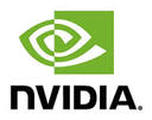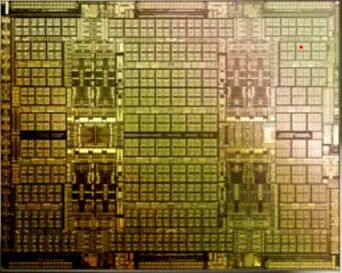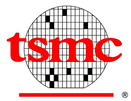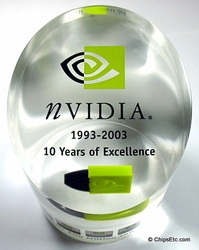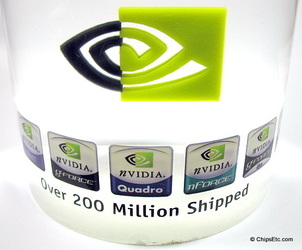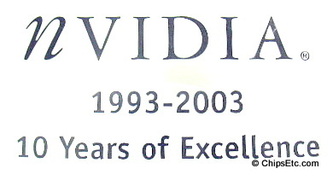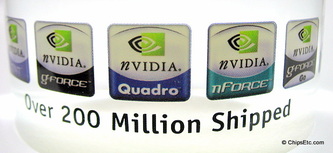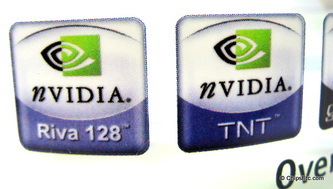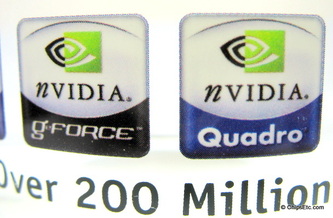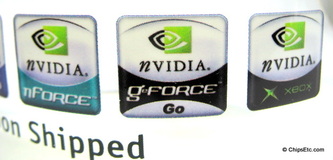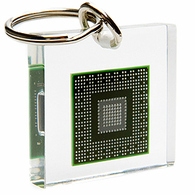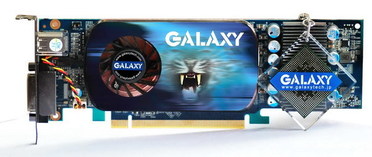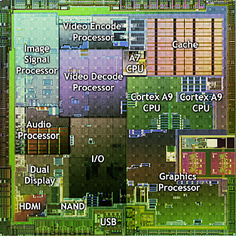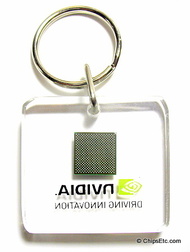|
Company: NVIDIA Corporation
Based: Santa Clara, CA. Founded: 1993 Founders: Jen-Hsun Huang, Chris Malachowsky & Curtis Priem Specialty: Founded by Microprocessor designers from AMD and Sun, Invented the GPU, developer of wireless communications processors & Chipsets for Computers, Video Game Consoles, Smartphones, tablets, Mobile devices and autonomous vehicles. NVIDIA's chips were irginally manufactured by SGS-Thomson Microelectronics, but now are manufactured by Taiwan Semiconductor Co., Ltd. (TSMC) |
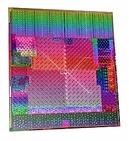
GPU (Graphics Processing Unit)
a single-chip processor with integrated transform, lighting, triangle setup / clipping, & rendering engines that is capable of processing a minimum of 10 million polygons per second.
History of NVIDIA's Semiconductor Foundry Wafer Manufacturing partnerships:
SGS-Thomson Microelectronics Taiwan Semiconductor Manufacturing
NVIDIA Historical Timeline
1993 NVIDIA Corporation is founded
1994 First manufacturing partnership is formed with SGS-Thomson Microelectronics (now STmicroelectronics)
1995 NVIDIA's first graphics accelerator chip is introduced, the NV1, manufactured by SGS-Thomson Microelectronics
1995 Sega's "Virtua Fighter" is first 3D video game to run on NVIDIA graphics
1997 World's first 128-bit 3D graphics processor is introduced, the NVIDIA RIVA 128 NV3
1997 NVIDIA voted industry's most respected private fabless semiconductor company
1998 NVIDIA forms new manufacturing partnership with Taiwan Semiconductor Manufacturing Company (TSMC)
1999 Invents the world's first GPU, the GeForce 256, manufactured by TSMC
1999 NVIDIA announces initial public stock offering on NASDAQ at $12 a share
2000 NVIDIA acquires competitor 3DFX
2000 Microsoft selects NVIDIA to provide the GPU for their first XBOX gaming system
2000 World's first GPU for notebook computers is introduced, the NVIDIA GeForce2 Go.
2001 NVIDIA invents the first programmable GPU, the GeForce3
2001 NVIDIA becomes fastest semiconductor company ever to reach revenue of $1 billion
2001 NVIDIA stock added to the S & P 500
2001 NVIDIA nForce integrated graphics chipset is introduced for use with AMD Athlon / Duron powered PC's
2002 NVIDIA ships their 100 millionth graphics processor
2002 NVIDIA named fastest growing company in the U.S.
2004 NASA uses NVIDIA technology to 3D render the terrain on Mars
2005 NVIDIA selected to develop the graphics processor for the Sony PlayStation 3 video game console
2006 NVIDIA introduces the CUDA parallel computing platform & programming model for use with their GPU's
2006 NVIDIA ships their 500 millionth graphics processor
2007 First quarter to reach $1 Billion in revenue
2007 NVIDIA introduces their Tesla GPU, designed for high-performance scientific, engineering, and technical computing
2008 Launches PhysX physics engine software for desktops and gaming consoles
2008 Tsubame 1.2 Japanese supercomputer with 680 NVIDIA Tesla GPUs ranks 29th fastest supercomputer in the world
2008 NVIDIA's Tegra mobile processor is introduced for notebook computers
2008 Apple chooses NVIDIA GeForce 9400M GPU for their new MacBook, MacBook Pro & MacBook Air notebooks
2010 Introduces the NVIDIA Tegra 2, the first Dual-core SOC Mobile chip for android tablets & smartphones
2012 NVIDIA announces the world's first GPU for cloud computing, the Nvidia VGX
2012 NVIDIA announces their Tegra 3 chip will be used in Audi's In-Vehicle Infotainment systems and digital display.
2021 NVIDIA announces their Nvidia CMP (Crypto Mining Processor), a GPU card made specifically for Crypto Currency Mining, which will have no video outputs, and run at a lower power
NVIDIA 10 year anniversary of Graphic Chips & GPUs Paperweight (2003)
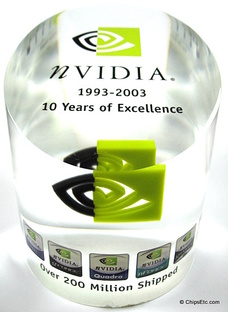
Item #776
This NVIDIA Lucite anniversary paperweight was created to celebrate their highly successful video accelerator chips and GPU's that they have shipped during NVIDIA's first 10 years.
Taiwan Semiconductor (TSMC) has been NVIDIA's primary chip manufacturing foundry since they formed a partnership together in 1998, manufacturing NVIDIA's numerous GPU technologies.
On the front of the paperweight it reads "1993-2003. 10 years of Excellence" and "Over 200 million shipped". There is a 3D version of the NVIDIA logo embedded in the center of the paperweight.
At the bottom of the paperweight the logo badges are shown for NVIDIA's graphic chips & GPU's released during their first ten years:
- Riva 128 (1997) "NV3" one of the first graphic chips to integrate 3D acceleration along with traditional 2D and video acceleration
- TNT (1998) "NV4" 90MHz 2D/3D/video graphics accelerator chip for the PC
- GeForce (1999) "NV10" 120MHz, The worlds first GPU
- Quadro (1999) "NV10GL" High-end GPU for CAD and DCC (digital content creation) workstations
- nForce (2001) 266MHz, Integrated Graphics Chip-set created for AMD Athlon and Duron CPU's
- GeForce Go (2000) The worlds first mobile GPU for notebooks
- Xbox (2001) "NV2A" 233 MHz custom GPU created for the Microsoft Xbox gaming console
Measures 3-3/4" wide x 4-3/4" tall.
NVIDIA / TSMC G98 GPU Chip Keychain (2009)
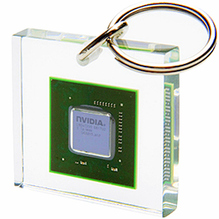
Item #435 (#436 similiar)
NVIDIA is a Fab-Less Semiconductor design company that contracts manufacturing of it's GPU processors to Taiwan Semiconductor Manufacturing Co., Ltd. (TSMC).
NVIDIA and TSMC began high-volume production in 1998 when NVIDIA was developing processors on 0.35 micron technology.
Today, NVIDIA leverages TSMC's process technology leadership and is producing processors in state-of-the-art 300mm 300mm wafer fabs.
This is an NVIDIA G98 GPU Chip encased in Lucite with lasered NVIDIA logo on top of the chip. This GPU was manufactured by TSMC using 65nm technology.
The G98 GPU introduced in June 2008 would have been used in the 9300 GE/GS series of Video Cards from NVIDIA, as well as in the GeForce 9100 & 9200 series. Since the chip found it's way into a keychain it is typically a rejected, flawed or under-performing unit that was not suitable for sale to a customer.
The NVIDIA G98 GPU offered an improved memory controller to compete with their biggest competitor's latest chip, the ATI technologies RV670 GPU. The G98 chip had 16 shader processors and it operated at 450 MHz.
Measures 1.5" square.
NVIDIA store part #GS-NV1544
NVIDIA and TSMC began high-volume production in 1998 when NVIDIA was developing processors on 0.35 micron technology.
Today, NVIDIA leverages TSMC's process technology leadership and is producing processors in state-of-the-art 300mm 300mm wafer fabs.
This is an NVIDIA G98 GPU Chip encased in Lucite with lasered NVIDIA logo on top of the chip. This GPU was manufactured by TSMC using 65nm technology.
The G98 GPU introduced in June 2008 would have been used in the 9300 GE/GS series of Video Cards from NVIDIA, as well as in the GeForce 9100 & 9200 series. Since the chip found it's way into a keychain it is typically a rejected, flawed or under-performing unit that was not suitable for sale to a customer.
The NVIDIA G98 GPU offered an improved memory controller to compete with their biggest competitor's latest chip, the ATI technologies RV670 GPU. The G98 chip had 16 shader processors and it operated at 450 MHz.
Measures 1.5" square.
NVIDIA store part #GS-NV1544
Galaxy G94 NVIDIA / TSMC GPU Keychain (2009)
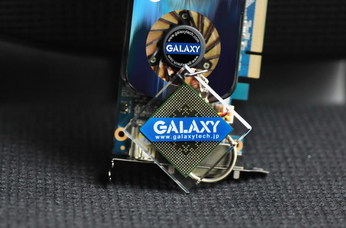
Courtesy of GALAXY Microsystems Ltd.
Galaxy, a maker of video cards using NVIDIA GPU's offered it's own version of the NVIDIA keychain in 2009.
The keychain featured a different chip however, the NVIDIA G94 GPU, and was awarded as a prize at Galaxy promotional events. It not offered for sale to the public like NVIDIA 's keychains were.
Clear Lucite, measures 1.5" square.
The keychain featured a different chip however, the NVIDIA G94 GPU, and was awarded as a prize at Galaxy promotional events. It not offered for sale to the public like NVIDIA 's keychains were.
Clear Lucite, measures 1.5" square.
NVIDIA TEGRA Mobile SOC Chip Keychain (2010)
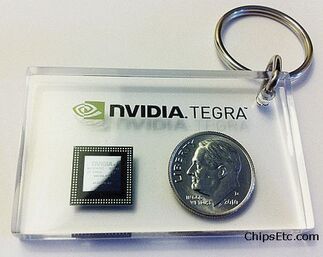
This is an NVIDIA keychain given out as a promotion to attendees at the 2010 CES Consumer Electronics Show.
It contains an NVIDIA Tegra Mobile SoC chip embedded in Lucite.
The Tegra chip were designed for mobile devices such as smart phones, smart books, media players, and PDA's.
This is an NVIDIA keychain given out as a promotion to attendees at the 2010 CES Consumer Electronics Show.
It contains an NVIDIA Tegra Mobile SoC chip embedded in Lucite.
The Tegra chip were designed for mobile devices such as smart phones, smart books, media players, and PDA's.
NVIDIA Tegra 2 SOC Mobile Chip Keychain (2011)
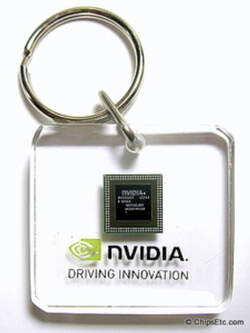 Item #832
Item #832
This is an NVIDIA keychain that contains an NVIDIA Tegra 2 Mobile SoC (system on a chip) embedded in Lucite.
The NVIDIA Tegra 2 processor (AP20H) powered mobile devices including Android smartphones and tablets and competed directly with the Apple A4 SoC chip.
The 1 GHz Tegra 2 SoC chip integrated both CPU (ARM Dual Cortex-A9 processors w/ 1 MB of on-die L2 cache), SDRAM memory (1GB) & GPU (ULP GeForce - 8 cores) onto a single silicon chip and was manufactured by TSMC using their 40 nm semiconductor wafer manufacturing technology.
This BGA (Ball Grid Array) Packaged Chip is marked with part # AP20H-PH-A4. Keychain reads "NVIDIA Driving Innovation".
New, unused, Measures 1.5" square.
This is an NVIDIA keychain that contains an NVIDIA Tegra 2 Mobile SoC (system on a chip) embedded in Lucite.
The NVIDIA Tegra 2 processor (AP20H) powered mobile devices including Android smartphones and tablets and competed directly with the Apple A4 SoC chip.
The 1 GHz Tegra 2 SoC chip integrated both CPU (ARM Dual Cortex-A9 processors w/ 1 MB of on-die L2 cache), SDRAM memory (1GB) & GPU (ULP GeForce - 8 cores) onto a single silicon chip and was manufactured by TSMC using their 40 nm semiconductor wafer manufacturing technology.
This BGA (Ball Grid Array) Packaged Chip is marked with part # AP20H-PH-A4. Keychain reads "NVIDIA Driving Innovation".
New, unused, Measures 1.5" square.
NVIDIA PCB Engineer's Design ruler (2012)

This is an NVIDIA PCB design ruler used by employees, and also given out as a promotional item, or gift. Offered exclusively at the Nvidia employee gift store.
Measures 12" long.
This is an NVIDIA PCB design ruler used by employees, and also given out as a promotional item, or gift. Offered exclusively at the Nvidia employee gift store.
Measures 12" long.
